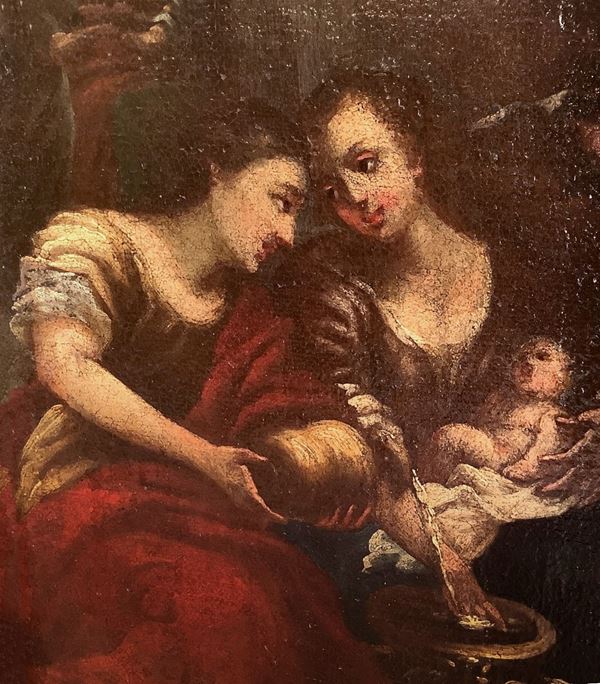Nativity of the Madonna, Second half of the 17th century
Emilian painter of the second half of the 17th century, antique frame.
In an interior illuminated by a distant flame, a putto with excited movement raises a reddish curtain, thus discovering the main scene of the painting: the nativity of the Virgin Mary. Two young maids, placed on the left side of the scene, with an accomplice exchange of glances, one is preparing to pour water into a vase with classical accents - although these are returned with synthetic brushstrokes - the other holding Mary as a child. In the background, on the right, a source of light, caused by a fire beyond a threshold, partially illuminates the jamb of a door and only partially reveals the sketched face of the female figure in the background, also intent on tidying up the environment. Even more distant, last in the compositional space, high priests & nbsp; they talk under a curtain and prove to be extraneous to the fulcrum of the scene. & nbsp; & nbsp; & nbsp; & nbsp; & nbsp; & nbsp; & nbsp; & nbsp; & nbsp; & nbsp; & nbsp; & nbsp; & nbsp; & nbsp; & nbsp; & nbsp; & nbsp; & nbsp; & nbsp; & nbsp; & nbsp; & nbsp; & nbsp; & nbsp; & nbsp; & nbsp; & nbsp; & nbsp; & nbsp; & nbsp; & nbsp; & nbsp; & nbsp; & nbsp; & nbsp; & nbsp; & nbsp; & nbsp; & nbsp; & nbsp; & nbsp; & nbsp; & nbsp; & nbsp; & nbsp; & nbsp; & nbsp; & nbsp; & nbsp; & nbsp; & nbsp; & nbsp; & nbsp; & nbsp; & nbsp; & nbsp; & nbsp; & nbsp; & nbsp; & nbsp; & nbsp; & nbsp; & nbsp; & nbsp; & nbsp; & nbsp; & nbsp; & nbsp; & nbsp; & nbsp; & nbsp; & nbsp; & nbsp; & nbsp; & nbsp; & nbsp; & nbsp; & nbsp; & nbsp; & nbsp; & nbsp; & nbsp; & nbsp; & nbsp; & nbsp; & nbsp; & nbsp; & nbsp; The work is made with quick touches of color and has references of Caravaggesque memory, due to the distribution of light and the sobriety of the place. However, the observation of the clothes of the two handmaids in the foreground, their body strength and the compositional structure would seem to point towards what happened in the Emilian area in the late seventeenth century. It is therefore possible to assign the painting to an unknown Emilian exponent influenced by the stylistic features of a current that, several years ago, Ferdinando Bologna defined "Romanized classicism".








